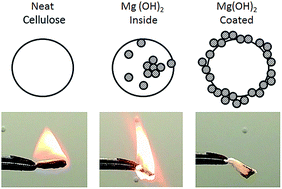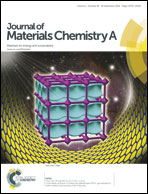Uniform nanoparticle coating of cellulose fibers during wet electrospinning†
Abstract
This work outlines a newly developed method that allows electrospun cellulose fibers to be coated with nanoparticles during dry-jet wet electrospinning. Cellulose fibers were wet electrospun from a room temperature ionic liquid solvent into a coagulation bath containing an aqueous suspension of magnesium hydroxide nanoparticles to prepare composites of nanofibers coated with functional nanoparticles. Flame retardant cellulose–magnesium hydroxide coated composite fibers were prepared to demonstrate this novel electrospinning method. The placement of the nanoparticles exclusively on the surface of the cellulose fibers dramatically impacted the functionality of the fibers. Electrospun cellulose fibers exhibited an onset of combustion in air at 239 °C and a maximum mass loss at 302 °C. Cellulose fibers with Mg(OH)2 nanoparticles (<50 nm avg. diameter) inside them exhibited an onset of combustion at 267 °C and a maximum mass loss at 315 °C. Cellulose fibers with the same nanoparticles uniformly coated on their surfaces exhibited an onset of combustion at 276 °C and a maximum mass loss at 318 °C. When larger Mg(OH)2 nanoparticles (>100 nm avg. diameter) were used, the onset of combustion was 185 °C and the maximum mass loss was at 216 °C when nanoparticles were inside the fibers, and the onset of combustion was 263 °C and the maximum mass loss was at 317 °C for Mg(OH)2 nanoparticle coated cellulose fibers. Simple flame tests showed a similar trend, with nanoparticle-coated fibers being fire resistant and fibers with nanoparticles inside burned rapidly upon exposure to an open flame.


 Please wait while we load your content...
Please wait while we load your content...